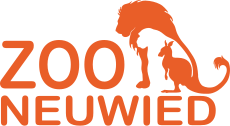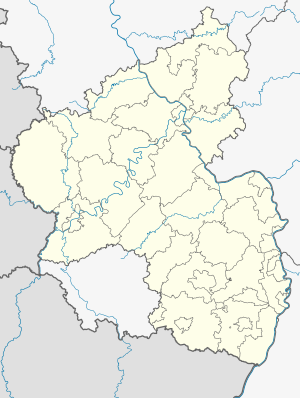Neuwied Zoo
| Neuwied Zoo | ||
|---|---|---|
| motto | love at first sight | |
| particularities | largest flock of gray kangaroos outside Australia, breeding pack of Berber lions | |
| place | Waldstrasse 160 56566 Neuwied |
|
| surface | 13.5 hectares | |
| opening | 1970 | |
| Animal species | 183 species | |
| Individuals | approx. 1,543 animals | |
| Visitor numbers | approx. 270,000 annually | |
| organization | ||
| management | Mirko Thiel (Director) | |
| Sponsorship | Friends of Zoo Neuwied eV | |
| Funding organizations | Friends of Zoo Neuwied eV | |
| Member of | EAZA , VdZ | |
|
Entrance building |
||
| www.zooneuwied.de | ||
|
|
||
Coordinates: 50 ° 27 ′ 11 " N , 7 ° 33 ′ 45" E
The Neuwied Zoo is an animal park on the outskirts of the city of Neuwied in Rhineland-Palatinate, east of the Heimbach-Weis district on the edge of the Rhine-Westerwald Nature Park . In 2007 the zoo had over 270,000 visitors.
Brief description
The zoo holds around 1,543 animals from 183 species. Its total area is around 13.5 hectares . There is, among other things, the largest herd of the giant gray kangaroos outside of Australia on an approximately 3.5 hectare site, socialized with Bennett kangaroos and emus . In addition, since 2004 lives a small breeding herd of extinct in the wild Barbary lions in the zoo Neuwied, which brought to 2010 ten pups. Four chimpanzees and three different species of marmosets live in the new, large ape house . In addition to lions and tigers, cheetahs enlarge the group of big cats - with a feeding system that is unique in Germany. Set within a spacious outdoor areas, the 'Africa savannah, "can a herd of Watusi cattle see which of wildebeest are associated, Sitatungas and South African blue-necked ostriches. There is also a large aviary with southern ground hornbills .
history
The Neuwied Zoo was opened to visitors for the first time in 1970. At that time it was called "Zoo Hubertushof". At the time, the Australian animals were well represented. The main attractions were marsupial devils , beaked hedgehogs , dingoes , bare-nosed wombats , cockatoos , spotted martens , mourning swans and the large herd of kangaroos .
The Neuwied Zoo had great breeding successes early on, including the first German breeding of South African billy goats and the world's first breeding of various parrot species. Further breeding successes include the natural rearing of African ostriches , in which, for the first time in Germany, the eggs are successfully incubated by the animals themselves instead of in the incubator, and the breeding of red chalk pelicans , which are native to Madagascar and the southern half of Africa.
In 1980 the area was leased by an animal dealer who ran it as a private and animal trade zoo, displayed animals bought there and then sold them on. At times, elephants , gorillas and hippos were also housed in the zoo. However, as there were problems with species protection, the animal dealer had to give up the site in 1985. The Neuwied Zoo was almost closed at the time.
In 1984 some committed citizens founded a development association, which was mainly financed by donations, the proceeds from animal sales and the income from entrance fees. Since it was taken over by the Friends' Association, Neuwied Zoo has changed noticeably and is under scientific management, initially by the biologist Heinrich Klein († September 24, 2011). Among other things, an exotarium with terrariums for reptiles and aviaries was built, the predator house was enlarged and in 1995 a large seal facility with underwater viewing tunnel and North Sea ambience was built.
In 2000 a new lemur house with an outside cage for white-headed lemurs was built, the new lion enclosure was completed in 2003 and a penguin enclosure in 2004, where 14 Humboldt penguins have moved in. In 2005 ten coatis were able to move into the zoo on a new facility and in 2006 the new ape house was completed. Where the chimpanzee enclosure used to be, there has been a New World monkey enclosure since March 2008 with a floor area of approx. 100 m² and an average height of 8 meters; it is lined with rock walls. In spring 2010, meerkats moved into the zoo for the first time. They live in the completely redesigned former zebra mongoose enclosure. The expanded tiger facility was opened in early summer 2010. In the spacious outdoor area, the big cats can swim in two pools and have more than 1000 m² of space available. Another milestone in zoo history was celebrated in May 2011. The old reptile house was over 50 years old. The new Exotarium has been built according to the most modern aspects for both animal husbandry and visitors. Giant snakes, lizards, monitor lizards and many other reptiles have moved into the new house and for the first time in the history of the zoo crocodiles are also being presented. In the new Exotarium with the approximately 500 m² display area, visitors can see not only reptiles but also insects and spiders, but also birds and mammals, which like it warm all year round, in the 38 large enclosures. In total, more than 120 animals from around 44 species now live here. The griffon vulture enclosure was completely redesigned in 2012. A rocky landscape and various nesting options as well as a water basin were installed here. The breeding facility for the cheetahs was completely renovated and redesigned in 2013.
The Neuwied Zoo still has many breeding successes today. The greatest success was when ten baby cheetahs were born in one day, eight of which were raised.
The Neuwied Zoo attaches particular importance to the care of children and offers a corresponding offer for schools as part of its own educational concept, but also the organization of children's parties. A petting zoo, tree and nature trail are part or complement to this.









